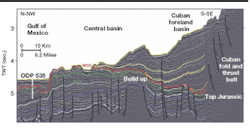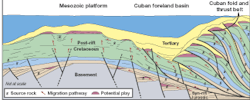Northwestern Cuba's deepwater potential
Fabrice Gaumet
Jean Letouzey
Institut Français du Pétrole
The Cuban Exclusive Economic Zone encompasses the western Florida Straits, the southeastern Gulf of Mexico (GoM), and the Yucatan Straits, up to the north-western Caribbean Sea. In 1999, the Cuban government divided this area into 59 blocks of about 2,000 sq km each. Six blocks covering the southern margin of the Mesozoic Florida platform are already contracted.
Compagnie Générale de Géophysique shot and processed a non-exclusive survey throughout the EEZ. The survey covered 7,332 km of new 2D lines plus 1,665 km of reprocessed 1980s lines. The Cuban deepwater area was reevaluated based on the CGG survey, new sedimentological/geochemical analyses from Cuban field sections and wells, and basin modeling. Within the Cuban EEZ, direct calibration for the seismic interpretation came from Offshore Drilling Program (ODP) well sites 535 and 540.
Physiographic setting
Cuba is an orogenic archipelago of Late Cretaceous-Middle Eocene age. It formed when the Great Antille volcanic arc collided with the continental margin of the North American plate. The steep margin that rimmed the northwestern coast of Cuba follows the main thrust front separating the Cuban fold and thrust belt from the Cuban foreland basin.
The southeastern GoM passes northward to the "Florida Plain," which is mostly underlain by Mesozoic oceanic crust. It is bounded by the steep Campeche and Florida escarpments. The main reentrant in the Yucatan margin (Catoche Tongue), as well as basement highs (Catoche Knoll, Pinar del Rio Knoll, Jordan Knoll), are linked to Jurassic structures. The whole northwest Cuba deepwater area has an underlying thinned continental crust inherited from the rifting phase of the Proto-Caribbean and of the GoM openings.
Geological setting
The Florida-Bahamas domain was previously a huge shallow-water mega-bank from Late Jurassic to Middle Cretaceous. After the Mid-Cretaceous drowning phase, carbonate banks persisted in various forms throughout the Florida-Bahamas domain, in which deep marine troughs canalized bottom currents from the Caribbean/GoM to the Atlantic Ocean.
Cuba and surrounding domains recorded three main structural phases:
- An extensional/passive margin phase associated with the breakup of Pangea - Late Triassic (?) to Campanian
- A collisional phase, due to the northeastward migration of the Great Antille Volcanic Arc and its collision with the North American plate. (Late Cretaceous-Middle Eocene)
- A post-collision phase when the convergence between the North American and Caribbean plates shifted toward the Eastern Caribbean along the Lesser Antille Arc.
The rifting stage of the Pangea breakup started in Late Triassic(?)/Early Jurassic times with the deposition of continental and marine clastic facies. It ended in Callovian time with the deposition of post-rift salts throughout the Gulf. A proto-Caribbean rift also developed from the Yucatan Straits up to the western Florida Straits.
The salt/anhydrite sequence of Callovian age was deposited in North Cuba and in the western Florida Straits and became the basal detachment of the Cuban thrust belt. An Upper Jurassic rift system was active in the northern part of the Central basin. It aborted in the Late Berriasian when oceanic crust spreading ceased in the Gulf. During the Upper Jurassic, shallow water carbonate platforms and hyper-saline lagoons were vertically stacked along the proto-Caribbean margin.
A carbonate sequence sealed most of the rift structures during Late Berriasian time. Rapid thermal subsidence then affected the southeastern GoM. Thick constructive Lower-Middle Cretaceous carbonate platforms, about 1,500 m thick, developed in the Yucatan and Florida domains. In the Florida paleo-margin, stacked bioclastic platforms prograded toward the Central basin. The Lower Cretaceous shelf margins extended up to the Campeche and Florida escarpments. A deep seaway connected the GoM and the proto-Caribbean oceans. The Central basin was relatively starved in sediments along the Yucatan, while relatively thick basinal/slope carbonates accumulated in the front of the western Florida paleo-margin. Shallow water conditions were also maintained over isolated build-ups, which were inherited Jurassic topographic highs.
Isolated carbonate build-ups grew from the Aptian. Intra-shelf deep seaways developed over the previous Florida mega-platform. They were filled by deep-water carbonate facies. The seaway initiation was partly controlled by reactivated basement faults, and by a paleo-oceanographic change when the south Atlantic ocean drifted.
The Atlantic-GoM connection significantly modified current flows. Current intensification and sediment starvation produced a major unconformity throughout the Central basin. Generally called the Middle Cretaceous Unconformity (MCU), it started after the Late Cenomanian. The MCU is locally closed to sea-bottom by the stacking of successive current-induced unconformities.
Main platforms contemporaneously stepped back toward the Yucatan and the Florida areas during the Upper Cretaceous. Shallow water carbonate platforms continued to growth in northern Cuba Remedios Belt, in Cay Sal Bank, and probably in the western Florida Straits as small isolated build-ups over the Lower-Middle Cretaceous shelf margin. A diffractant karst-type seismic facies covered the western Florida Straits.
Deep marine flyschs and volcanic-ophiolitic melange were deposited in the foreland basin when the Great Antille Arc progressively collided the Florida paleo-margin (Paleocene to Middle Eocene). Mesozoic carbonates and syn-tectonic deposits were incorporated in the Cuban fold and thrust belt. After the main Cuban thrusting event, Tertiary clastics and deep marine flyschs were deposited in the Cuban foreland basin. Shallow water platforms persisted in Yucatan, South Florida, and Cay Sal. During the Neogene, reverse faults determined east-west elongated compressive structures along the western Florida Straits.
Petroleum systems
The occurrence of at least one active petroleum system in Cuba EEZ is attested by the presence of asphalt in fractures and adjacent oil stained levels in the ODP well 535 site. Two petroleum systems exist in Cuba and may extend into the northwestern Cuban deepwater zone. The first has a Jurassic source rock, which is related to the syn-rift sedimentary system. This source rock, San Cayetano Fm., is mature to over mature with a remnant total organic content (TOC) between 0.7 and 1.5%. It is a marine silicoclastic sequence with thin alternations of black shales and siltstones. This deepest system may be connected to the second system, depending on the presence of the Jurassic evaporites, which may act as seal.
The second petroleum system is related to the post-rift deepwater carbonate system. It is made of Upper Jurassic to Middle Cretaceous source rocks, which are also fractured reservoirs in the northern Cuba fold and thrust belt. Mean TOC values vary between 3 and 6%. Molecular analyses and crude oils/source rocks correlations support that the organic matter accumulated in a carbonate environment under restricted anoxic/hypersaline conditions.
A third petroleum system is known in the US Florida domain. It could extend southward in the Florida Straits at the north of the Mesozoic carbonate shelf margin. Source rocks filled intra-shelf carbonate basins during Upper Jurassic- Lower Cretaceous times. Generated oils accumulated in the Sunniland trend from type II source rocks. They are composed of organic-rich algal carbonate units inter-bedded with marine limestones/dolostones and evaporites.
The Cuban fold and thrust belt has a proven hydrocarbon system known by more than 15 oil fields along the coast. Maturation is associated with tectonic burial and syn-tectonic foreland deposits. Oils were mostly early mature heavy oils without significant biodegradations. Structural traps are highly tectonized carbonate thrust-sheets. Reservoirs are fractured deep-water carbonates. They are sealed by Paleocene syn-flexural shales imbricated within the thrust belt and post-tectonic units. Although it is badly imaged by seismic, it exists across a vast unexplored portion in adjacent offshore settings.
Thrusts incorporate both Mesozoic carbonate sediments and foreland Tertiary sediments over a Mid-Jurassic detachment level. Below it, the syn-rift source rock must be over mature. The petroleum potential of this thrust domain is associated with deepwater post-rift source rocks, deposited up to the northern limit of the foreland basin. We expect more maturation and better oil quality in the deep buried thrust sheet below the Tertiary foreland deposits. Lower Tertiary shales deposited against the thrust front and within the thrust pile may be efficient seals.
The unexplored foreland basin is the main kitchen for oil generation. This is due to the increased burial by the stacking of the thrusts and of the Tertiary foredeep deposits. The post-rift petroleum system may actually generate important amounts of hydrocarbon, while the syn-rift system is over mature below the thrusts in the deeper part of the foreland basin.
In the western Straits of Florida, thick Jurassic evaporite sequences act as a good seal. An exploration trend exists along the buried Mesozoic Florida margin located in the western Florida Straits. Potential traps and reservoirs are expected in carbonate shelf edge facies, isolated platform build-ups, and coarse-grained fore-reef deposits. Late Tertiary fault reactivations also create structural traps.
In the Central basin, the Tertiary is very thin, notably over paleo-highs. Main oil seeps could exist where the top of Mesozoic carbonates is close to the basin floor. Some Jurassic grabens are deep enough to be in the oil window. The current transformation ratio is the one obtained before the Upper Cretaceous, due to thin post-MCU deposits. So if a sealing horizon exists in this area, the oldest traps may have been filled and preserved from this time.
- Regional bathymetry map of offshore Cuba showing 59 lease blocks, CGG seismic grid, and ODP well sites 535 and 540.
- NNW-SSE seismic section tying ODP 535. Note the Mid-Cretaceous Unconfomity in red and carbonate buildups over a basement horst.
- Oil maturation is associated with tectonic burial and syn-tectonic foreland deposits as shown by this model predicting maturation and flow paths.
- Play concept schematic demonstrating plays in the syn-rift Jurassic, post-rift Cretaceous, and fold and thrust belt zone. Lower Tertiary shales may form efficient seals.
Another good exploration trend is located along the buried Mesozoic Yucatan margin. Hydrocarbons generated below the foreland basin could have moved toward the Mesozoic carbonate shelf margin and associated build-ups. The rapid thinning of the Tertiary foreland deposits limits the prospective area to the west. Like the Central Basin, the deepest levels of Jurassic half-grabens could be in the oil window.
Conclusion
The Cuban EEZ has significant hydrocarbon exploration potential. The first exploration trend could be the deeply buried thrust in front of the Cuban fold and thrust belt. We can expect more mature oil and gas than the early-mature heavy oil found in North Cuba oilfields. The post-rift petroleum system associated with Upper Jurassic-Middle Cretaceous deepwater source rocks may occur and be active below and north of the present North Cuba foredeep basin. We expect important lateral oil migration to the north and to the northwest from the Cuban foreland basin.
The second exploration trend rims the Cuban foreland basin. It corresponds to the buried Mesozoic carbonate shelf margins of Yucatan and Florida, below Tertiary deepwater sediments.
Finally, deep Jurassic grabens may have generated some hydrocarbons in the Central basin and in the Yucatan Straits.
The main unresolved or limiting parameters for exploration in the Cuban EEZ are:
- The influence of diagenesis and karstification on carbonate reservoir properties
- The sealing capacity of post-MCU sediments north of the Cuban foreland basin during oil migration
- The effect of biodegradation.
The most prospective areas appear to be both the unexplored offshore extension of the Cuban fold and thrust belt and the Cuban foreland basin from the Yucatan Straits up to the western Florida Straits.
Acknowledgements
This integrated study was carried out under a research agreement between Cupet, CGG, and IFP, with the participation of TotalFinaElf. CGG provided seismic lines. The project received the financial support of the French industry minister (Coprep project n° G5314/01). Contributors to this study include: J. Sanchez, J.G. Lopez, O. Lopez, E. Linares, G. Hernandez, R. Tenreyro, S. Zimine, P. Lapointe, I. Moretti, and C. Magnier.
References
A complete list of references is available from the author ([email protected]). For a complete report and seismic, contact J. Mondin at CGG ([email protected]). For further contacts in Cuba contact, Dr. G. Hernandez ([email protected]).




